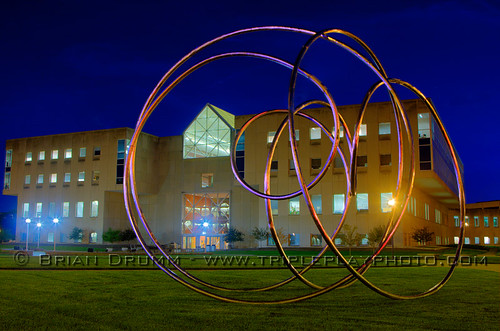I should probably start this entry by stating a few things that I am NOT. I am not an oracle or a psychic. I am not a Canon fanboy and am not in the Canon inner circle or connected with the company in any way. I am not a Canon evangelist or a Nikon detractor. (I have a spreadsheet calculating the cost/benefit of a switch to Nikon to prove that.)
Recently, a mole at Best Buy revealed new UPC product database entries had been created for the Canon G11, S90, and 7D. That a G11 was eventually coming is a no-brainer. The "G" series has updated on a more-than-annual basis for years.
The S90, on the other hand, is thought to be a much more counterintuitive development. I have to take other web posts at their word on this, since I do not follow developments surrounding this type of camera. But, if we accept that the S90 prediction was either based on fact or an
exceptionally lucky guess, the 7D gets added credibility, as well as a blogospheric tornado of speculation on it's specifications.
To amalgamate the myriad estimations of 7D capabilities, the new camera will most probably:
• be anywhere from 12 to 21 megapixels.
• have one, or perhaps two, digic IV processors or debut a Digic V.
• do HD video up to 1080p.
• have a 3.9 framp-per-second shooting rate.
• or, maybe, 8 fps.
• or 5 fps. Who knows?
• slice.
• dice.
• chop.
• make julienne fries.
• cost about $2700.00 (body only).
• or around $1700.00.
• have built-in pop-up flash. Or not.
• employ an APS-C 1.6x crop sensor.
• Oh, never mind. It's full-frame.
• have 15 focus points.
• No, make that 19 focus points.
• why not
one meeee-lee-uhn focus points?.
• give you oral pleasure.
• ISO 50 to ISO
one meeee-lee-uhn.
• have weather sealing comparable to EOS 1D MkIII.
The preceding list, delivered with tongue causing a rug burn on the inside of my cheek, goes to show how useless any speculation, including my own, truly is. As the old saw goes, "Anybody who knows isn't talking, and anybody who's talking doesn't know."
But what the hay? Speculatin's fun.
I went on record with an email to my friend Ron Wise over a week ago with the following predictions for the 7D:
• 16-ish MP with one or two sRaw modes
• up to 1080p video
• motor at least 6.5 fps
• 1.3x crop
• "real" ISO ratings to 6400, with "cheats" up to 25K
• one CF and one SD card slot
As I read this a week later, I find I still agree with myself. Nothing there is a particularly earth-shattering or out-of-the-box prediction with the possible exception of the 1.3x crop. I haven't seen that prediction anywhere else on the web. And like every other prediction out there, I pulled that out of a very dark and smelly place. But it still sounds right to me. And here's why:
I think Canon has realized (or
should realize) that the advanced amateurs at whom the 10D thru 50D series has been aimed are just about played out on 1.6x crop sensors. Nobody who has shot with or even looked through a 5D has not pined for a larger sensor. Another 1.6x sensor is not going to excite like an upgraded 1.3x sensor would.
Also, as I recall, the 10D debuted at about $2000.00, and the 50D is now listing for $1199.00. That's at least a 40% deflation in price in a relatively short few years, which has to cut deeply into profit margin. If, as some have suggested, a 60D is also about to be released, the expectation will be for a big boost in features at the same price, or an incremental improvement for at least a slightly lower price. Video capability of the Rebel T1i notwithstanding, the current 50D is a significantly more solid-built camera with many more features than the Rebel for not a lot more money. Canon surely wants to introduce a new pro-sumer toy that can command a larger profit margin. 1.3x crop on the sensor will help with this.
Releasing a 60D simply does not make sense to me. Releasing a 60D alongside a 7D would be market-diluting lunacy.
The sleeping giant through all this 7D rumoring is the surely-impending update in the 1D line. But lately I've been wondering if it is still going to be a "line" at all. Without a doubt, the Nikon D3 is the camera to beat right now. And Nikon has apparently abandoned any kind of crop sensor on it's pro cameras. Would this not put pressure on Canon to do the same?
I suspect we have seen the last EOS 1DS camera. The next pro camera will be full-frame and the APS-H sensor format will go by the wayside for pro Canons. That's another reason I think the 7D will be 1.3x crop. It will essentially fill the niche that will not be filled by a successor to the current 1.3x-crop 1D MarkIII (at least in my fevered imagination).
Were I CEO of Canon, engineers would have been tasked many months ago to design a camera with the fullest flexibility for any pro shooting situation. Need to shoot a full-bleed magazine cover or a portrait suitable for extensive retouching and uber-large reproduction? Shoot 25-30 megapixels with motor speed of around 5 fps. Shooting a fast paced sporting event where most of your work will display half-page or less in print or on the web? Drop down to about 12MP resolution and crank away at 10 or 12 fps.
Essentially, to regain it's competitive leg up, Canon should strive to deliver a camera that combines the Nikon D3 and D3X into one machine, and do it at around the price of the D3. In today's economy, few professionals have the luxury to specialize only in high-end commercial work at the expense of fast-paced editorial photography. And top-line cameras should not force professionals to pay top-dollar for a "specialist" SLR.
 Our neighborhood is poorer as of yesterday with the passing of Shania, a lovely and charming Siberian Husky who shared her two bedroom, two bath, 1 1/2 garage home with my good friend (and best "man" at my wedding) Eileen Cantin.
Our neighborhood is poorer as of yesterday with the passing of Shania, a lovely and charming Siberian Husky who shared her two bedroom, two bath, 1 1/2 garage home with my good friend (and best "man" at my wedding) Eileen Cantin.
 I'm posting an AppleScript I just wrote which I hope might be useful to some people who listen to podcasts in iTunes. Paste the script text shown below into a Script Editor window and save it as a compiled script in the iTunes Script folder. After you re-launch iTunes, you will be able to invoke it from your Script menu in iTunes. The purpose of the compiled script is to skip forward 30 seconds in the currently playing track. Some folks may have other uses for it, but I find it very handy to jump forward quickly when certain podcasts go into "commercial mode."
I'm posting an AppleScript I just wrote which I hope might be useful to some people who listen to podcasts in iTunes. Paste the script text shown below into a Script Editor window and save it as a compiled script in the iTunes Script folder. After you re-launch iTunes, you will be able to invoke it from your Script menu in iTunes. The purpose of the compiled script is to skip forward 30 seconds in the currently playing track. Some folks may have other uses for it, but I find it very handy to jump forward quickly when certain podcasts go into "commercial mode."


 This simple, easy, and cheap method comes courtesy of plastic name tag holders. These are readily available at office supply stores, and many of you have probably packratted away a few of them already if you ever attend or work at seminars, sports events, or other credentialed or "managed access" events. The one's I've used measure about 3 1/4" by 4 1/4". Some have clips to attach to lapels or pockets, others have lanyards. It doesn't matter which you have, because we are only using about the bottom two thirds of the holder anyway (uncut and cut-down tag holders seen here).
This simple, easy, and cheap method comes courtesy of plastic name tag holders. These are readily available at office supply stores, and many of you have probably packratted away a few of them already if you ever attend or work at seminars, sports events, or other credentialed or "managed access" events. The one's I've used measure about 3 1/4" by 4 1/4". Some have clips to attach to lapels or pockets, others have lanyards. It doesn't matter which you have, because we are only using about the bottom two thirds of the holder anyway (uncut and cut-down tag holders seen here). For the Vivitar 285/285HV (seen amber-gelled at right), you will want to cut the holder's height down to about two inches. Try to cut it for a rather snug fit so it does not want to slide out as you hand hold the flash in different positions or, heaven forfend, if you use the flash in the hot shoe and turn the camera vertically. Different holders have different degrees of "flex" so I can't give a precise measurement that will work with every tag holder.
For the Vivitar 285/285HV (seen amber-gelled at right), you will want to cut the holder's height down to about two inches. Try to cut it for a rather snug fit so it does not want to slide out as you hand hold the flash in different positions or, heaven forfend, if you use the flash in the hot shoe and turn the camera vertically. Different holders have different degrees of "flex" so I can't give a precise measurement that will work with every tag holder. My preferred flash is the Vivitar 283, and this same method works with the 283's accessory lens/filter adapter. I have about six of these and if you don't have one yet, they are available on eBay for ten bucks or less. While you're at it, pick up a lens kit LK-1 (also around ten bucks) so you can concentrate the light where you want it and compensate for some of the light loss from the gels (see red-gelled 283 with "L. Tele" lens at left).
My preferred flash is the Vivitar 283, and this same method works with the 283's accessory lens/filter adapter. I have about six of these and if you don't have one yet, they are available on eBay for ten bucks or less. While you're at it, pick up a lens kit LK-1 (also around ten bucks) so you can concentrate the light where you want it and compensate for some of the light loss from the gels (see red-gelled 283 with "L. Tele" lens at left).






